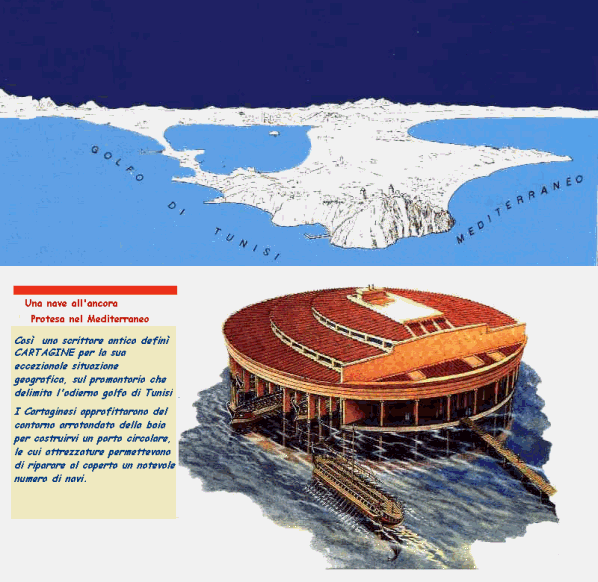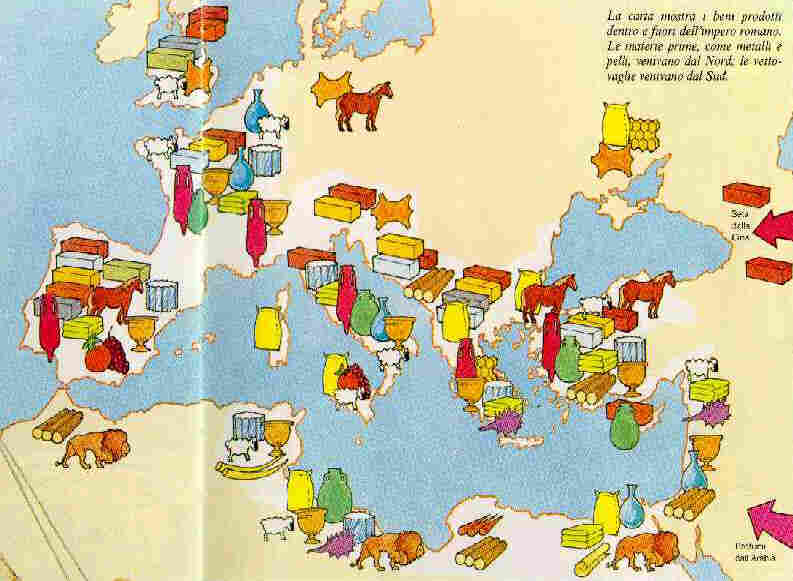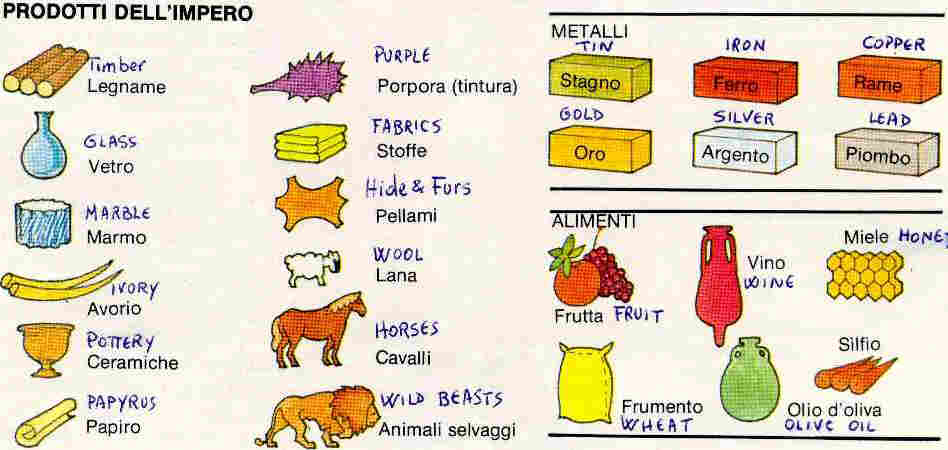 |
| The Roman conquest of the Mediterranean sea |
Some of the world’s earliest civilizations began along the shores of the Mediterranean, and it has served as a vital trade route for thousands of years. Since the most ancient periods it has had a unifying influence among the people living along its coasts, because its islands and peninsulas were like bridges uniting the opposing shores.
Phoenicians, Greeks, Carthaginians crossed it high and low, exploiting the natural and mineral resources of the soil, trading and founding colonies.
The dominion of these people was limited to single parts of the Mediterranean. The Romans, on the contrary, were able to dominate it all.
| ROME |
The origins of Rome
700 years before Christ, Rome was composed of a group of huts built upon a hill, later called Palatino. The climate was mild and the soil fertile. The inhabitants were mainly peasants who grew wheat, olive trees, vines and bred sheep and cattle in the fields around the village.
There were other villages on the six hills all around and, little by little, they united in a city, which included seven hills within its walls.
Its name was Rome.
The growth of Rome
The growth of Rome was not fortuitous, in fact near the Tiberine island, where Rome stretched, it was easy to cross the Tiber; moreover Rome was a fixed course between two very rich commercial regions: Etruria and Campania.
When the Tyrrhenian sea was stormy, merchants transported their goods by land, so they passed through Rome and contributed to its wealth.
The city was well defended by the pirates’ attacks because it was far enough from the coast, even if the distance was not a handicap for traders.
At the end of the 4th century B.C., after a series of wars lasting about fifty years, the Romans extended their dominions over Latium and central Italy, up to the Adriatic coast.
Now Rome was able to control the maritime traffic of both the Tyrrhenian and the Adriatic seas, but above all it came into contact with the maritime towns of "Magna Graecia".
The war against Tarentum
The expansion of Rome in southern Italy led to a war against the powerful city of Tarentum. This city controlled the sea trade in the Adriatic sea and represented an obstacle to the expansion of the Roman commerce in the Mediterranean.
The war was declared in 282 BC. Rome sent a naval fleet to the port of Tarentum, which was a city with seafaring traditions, but which had not a terrestrial army to oppose to Rome.
So Tarentum called Pyrrhus, king of Epirus (modern Albania) for help.
Pyrrhus landed in Italy with a powerful mercenary army and twenty elephants, ridden by groups of archers. The sight of those huge animals, never seen before, put the Romans to flight in two occasions. At last, during the third battle in Beneventum in 275 BC, the Romans frightened the elephants with flaming torches and won.
| Rome and Carthage |
The most powerful Phoenician city in western Mediterranean was Carthage.
Because of its exceptional geographical position, on the promontory stretching in the gulf of Tunis, it was described as "a ship at anchor". The Carthaginians built a circular port, where numerous ships could shelter under cover (see picture).
They occupied a very fertile land, tilled by the slaves and small farmers. They had developed a huge trade network, based on the export of agricultural products (such as wheat, figs, olive oil, walnuts) and the import of luxury goods (i.e. the valuable Greek pottery).
Carthage based its power on the control of the sea trade. Its mercantile vocation is well documented by its two ports: a freight port and a naval port.
Its navy was the best at that time; Punic merchants were able to get to very distant places, like Cornwall, where they stocked up on tin, or like the Atlantic African coasts, where they found gold and ivory.
Every ship sailing to western Mediterranean ports was obliged to pass under Carthage control of the loading and to pay custom duties before getting the permission to reach its destination port. The ships which tried to elude were sunk and the crew captured.
The Carthaginians had trading centres in Spain, in Sardinia and in Sicily. They had never had serious controversies with the Romans. In fact in 509 BC Rome and Carthage signed a treaty which established the reciprocal spheres of influence: Rome could expand in Italy, Carthage could expand in Sicily, both to the detriment of the Greeks.
The situation changed abruptly after the Roman victory over Pyrrhus, when the Romans got to the strait of Messina, they decided to cross it and landed in Sicily in 264 BC. It was a real war act which gave way to the Punic wars, a tremendous conflict which lasted over a century.
 |
The First Punic War |
In III century BC Carthage had the most powerful fleet in western Mediterranean. At the beginning of the war, the Romans possessed only cargo ships: however their organizing ability allowed them to build a large number of ships in four years only.
The first Punic war lasted from 264 to 241 BC and it was decided entirely at sea.
The Romans, accustomed to fight on land, realized immediately that they were disadvantaged on sea. So they rigged a fleet of 120 ships. Since Roman fitter-outs did not have a great experience in shipbuilding, they used a Carthaginian ship, fallen in their hands, as a model for their own vessels.
Roman ships were also rigged with new devices: the rostrum, used to break through the enemy ship, and the corvus, a drawbridge upon which it was possible for soldiers to fight as on land.
The first Roman victory happened at Mylae (Milazzo) in 260 BC, where the consul Caius Duilius sank one third of the enemy ships; 3,000 Carthaginians died and 7,000 were captured and made slaves.
The second victory occured at Cape Ecnomo in Sicily in 256 BC and it was the greatest ship battle ever fought at those times, with 150,000 men and 480 ships engaged.
The Romans, led by the consul Lucius Manilius Vulsone and Attilius Regulus, won.
Regulus landed in Africa and directed to Carthage, but a series of errors changed the victory into a defeat. Regulus was captured and executed while a Roman fleet, send to help him, was destroyed by some storms.
Then Rome with a huge effort, rigged out a large fleet which routed the Cathaginians at the Aegates islands.
During the war, in 254 a.C., there was also the battle of Panormus (Palermo), where the Romans succeded in defeating the enemy forces by sea and by land and conquered the city. Later on Rome let Palermo free to develop its flourishing trades.
Rome had won; Sicily passed under its dominion.
Since the beginning Sicily had been the real target of the conflict. Rome wanted its cities rich of treasures, its well equipped ports, but most of all its wheat. No other Italian region had such fertile plains and such big ears of wheat. Sicily became the granary of Rome.
The rivalry between Carthage and Rome went on and on and there were other two long and bloody wars, mainly fought on land, at the end of which Carthage was destroyed and Rome became the master of the Mediterranean, called "Mare Nostrum".
Merchant Navy and Trading |
During the imperial period, Rome had one million inhabitants: the farms did not produce enough food for them all, so it was necessary to import it. Since Julius Caesar’s times it had been common to import goods from abroad. The most important freight port was Ostia: from there the goods were transported on barges up the river Tiber. |
 |
 |
Every day cargo ships arrived at Ostia from all over the Empire. Some ships use to sail as far as India and their journey took a year. The map below shows the goods produced inside and outside the Roman Empire. Raw goods like metals and furs came from the north; food came from the south. |